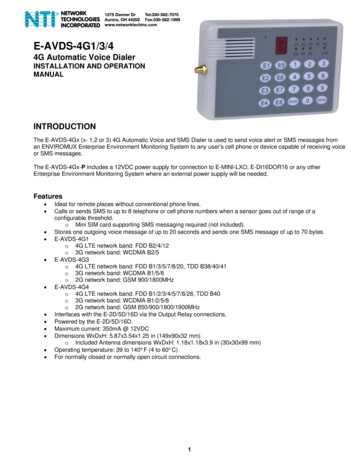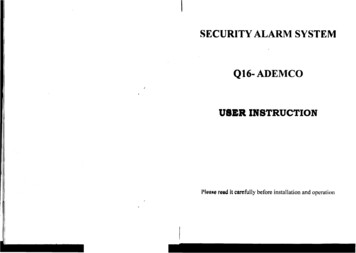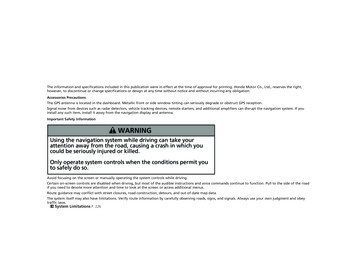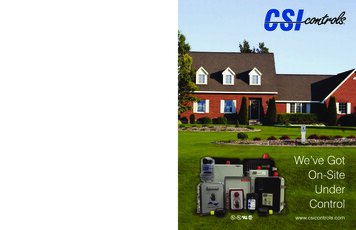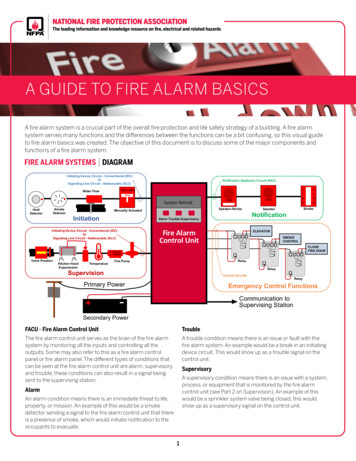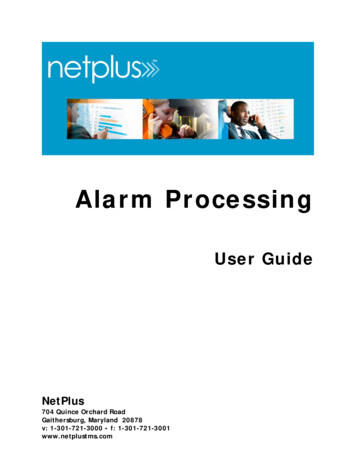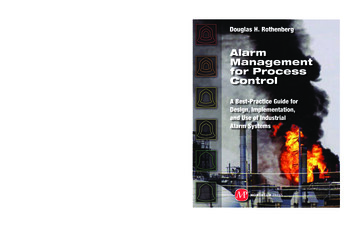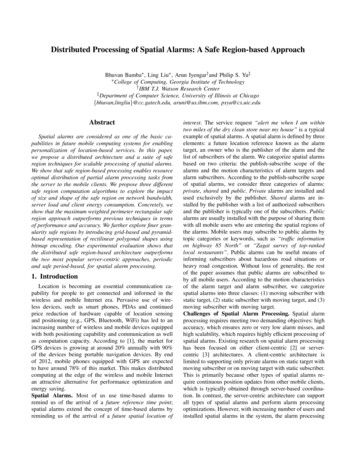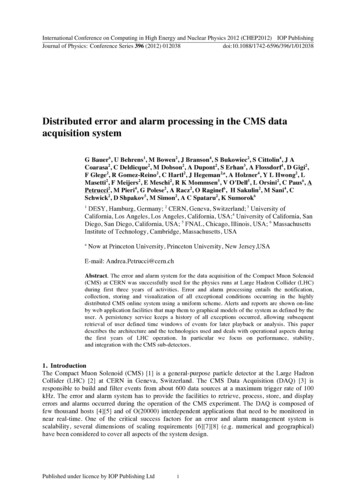
Transcription
SECTION 7: page 1Section 7.1:Voice AlarmDesign Guideby Honeywell
SECTION 7: page 37.1: V O I C E A L A R M D E S I G N G U I D Eby HoneywellThe following is a guide for designers on VA / PA systems, and their use in conjunction with advanced fire detection systems, incorporatingthe requirements of BS 5839-8:1998 It will highlight some of the main difficulties in system design paying particular attention tointelligibility, which is the key differentiator between good and poor design.Contents1Background research: why Voice Alarm is the future for Fire Alarm systems2The difference between Public Address (PA) and Voice Alarm (VA)3BS 5839 - 8 :1998 Fire detection and alarm systems for buildings3.1 Section 1 General3.2 Section 2 Design considerations3.3 Section 3 Workmanship, installation & commissioning3.4 Section 4 User responsibilities3.5 Annexes4Current solutions4.1 Voice sounders4.2 Central Rack systems4.3 Distributed amplifiers4.4 Loop powered micro amplifiers5Guideline for future designs1 Background research: why Voice Alarm is the future for Fire Alarm systems“It has often been observed that occupants – in the initial moments of a fire, upon smelling smoke or hearing the fire alarm – do not react;they deny there is danger or they ignore the situation. This seems especially true in public buildings where occupants do not want to be seento overreact to a false alarm or to a situation that is already under control. Such avoidance behaviour in a dangerous situation often results in adelayed start to evacuating a building or taking protective action”. This statement by Dr Guylène Proulx1 was further illustrated by research carriedout by Brian Piggott of the Fire Research Centre and published by David Canter of Surrey University2 which showed that in the event of a fire: 13% of people reacted to bells 45% of people reacted to text 75% of people reacted to voice!It was also made clear that in the event of an alarm people generally exit by the entrance they first used and need to be directed to the nearestescape route. A Voice Alarm system can be used to to give people clear information about when to evacuate and what route to take and hencealleviate some the of the problems highlighted above.2 The difference between Public Address (PA) and Voice Alarm (VA)Many people believe they can simply use their PA system to provide a voice message in the event of an emergency like a fire.Unfortunately PA systems, whilst very good for providing music and messages, are not guaranteed to work when there is an emergency. This iswhere the British Standard BS 5839 - 8:1998 on Voice Alarm comes into use, as it clearly defines the requirements of a true VA system. A trueVA system is a HIGHLY SECURE PUBLIC ADDRESS system which has the following features; All internal and external circuits are monitored for faults A minimum battery back up of 24 hours standby and 30 minutes alarm. A monitored secure link to a fire alarm panelReferences A number of pre-recorded emergency messages1: Guylène Proulx, Ph.D,’Misconceptions Incorporates an emergency ‘firemans’ microphoneabout human behaviour in fire emergencies’The use of speech sounders is not considered as a true VA system and therecommendations detailed within ‘annexe E’ of the standard should be consulted.published in Canadian Consulting Engineer,March 1997, pp36, 38.2: David Cantor, ‘Studies of Human Behaviourin Fire: Emprical results and their implicationsfor education and design.’ Published by BRE,July 1985
SECTION 7: page 47.1: V O I C E A L A R M D E S I G N G U I D Eby Honeywell3 BS 5839 - 8 :1998 Fire detection and alarm systems for buildingsThere is no substitute for reading the standard, this section only deals with the most obvious or possibly contentious issues facing the designer.Copies of this standard can be obtained from: British Standards Institute (BSI) at www.bsi-online.comWe also suggest reference is made to BS 5839 - 1:2002.The standard is split into various sections, the following looks at the key points for designers in each section.3.1 Section 1 GeneralThe key part of this section for a new design is the need to exchange information with interested parties, as it is likely that the informationgathered here will form the basis of the design. An understanding needs to be gained of what messages are to be played in the event of a fireor other emergencies as well as what the system may be asked to do in addition, ie music and/or paging.This section also provides a full planning schedule as a check list which is well worth following, especially for anyone who is embarking on adesign for the first time.The designers check list is as follows : Survey of the site and/or a detailed examination of site drawings including an acoustic assessment Assessment of usage of the building including; Periods of non occupation Areas with high noise levels Personnel including those hard of hearing Actions that take place in the event of a fire Liaison with all manufacturers to ensure compatibility between the fire and voice alarm systems A system specification and requirements for estimation purposes Tendering and quotation Consideration of proposals Consideration of servicing requirements Agreement on proposals and confirmation of ‘Fire plan’ Agreement on the ‘controls’ ie microphones etc Detailed system design Ordering Agreement on final specification including any variations Production, pre-delivery acceptance certificate and delivery Installation and testing phase Commissioning System documentation and user training Acceptance by client Handover of system Service agreement
SECTION 7: page 57.1: V O I C E A L A R M D E S I G N G U I D Eby HoneywellIt goes on to suggest that for large sites considerations be included for: Understanding the stages of a ‘critical path’ chart Siting and accommodation of the control equipment On site work not conflicting with other services Temporary physical protection to avoid deterioration of equipment due to damp, dust etc Ensuring final commissioning of the VA system is carried out when all parties can witness theresults under various occupation levels – it may be necessary to consider partial occupation andsoak testing to ensure all parties are ultimately satisfied with the final result3.2Section 2 Design considerationLike all the Fire application standards this section is by far the largest and additional training on thissection is advised for anyone heavily involved in VA design.Some of the KEY issues the designer should consider are:The Distribution of the speaker circuitsConsideration should be given to the degree of monitoring required, particularly for the speakercircuits. In certain circumstances it is recommended that they are interleaved to ensure the voicemessage is delivered throughout a zone, irrespective of whether one of the two circuits have failed.The Choice and siting of the speakersLoudspeakers should be positioned to achieve the correct sound pressure (dB) level and goodintelligibility, with an STI (speech transmission index) of 0.5 considered to be acceptable.Speaker selection should not be a simple matter of aesthetics and it is often advisable to carry out anacoustic survey to establish the best solution for a particular application.The Link between the Fire and VA control panelsThe link between the fire control panel and the Voice alarm control unit needs to be secure, that ismonitored for open and short circuits and wired in recognised fire resistant cables to avoid failure, asthe VA may be the only means of warning people there is a fire.In complex buildings where activation of the Evacuate and Alert signal can be manually overridden itshould be clearly indicated on the control panel which area is receiving which message.Combined use of Fire Sounders with VA systemIn certain circumstances a site may require VA in public areas whereas sounders can be used in staffonly areas. In such cases the operation of the sounders should not affect the intelligibility of the VA system The sounder tone should be the same as the ‘attention drawing tone’ used by the VA system The procedures for operating such systems should be simple to avoid confusion in the event ofan emergency If it is necessary to silence the alarm sounders to enable a voice message to be broadcast thenrestarting of the sounders should be automatic. There should not be a silent period exceeding10 seconds between broadcast and sounders
SECTION 7: page 67.1: V O I C E A L A R M D E S I G N G U I D Eby Honeywell3.3Section 3 Workmanship, installation & commissioningThe installation requirements follow closely the recommendations within BS5839-1:2002. However the crucial issue here is the commissioningstage especially checking of the sound pressure levels (dB’s) and intelligibility.Specialist equipment may be required to check the audibility and intelligibility. However the standard suggests that to check the sound pressurelevel, a standard sound level meter set to ‘A’ weighting and ‘slow response’ will give an approximate reading, as long as the speech is slow indelivery with virtually no gaps.Intelligibility is a little more difficult and whilst a minimum STI of 0.5 is quoted it may be difficult or near impossible to measure under allcircumstances. The standard suggests that a subjective assessment of intelligibility may be sufficient as long as all interested parties agree. In thecase of dispute it is recommended that an appropriate method of measurement detailed within BS EN 60268-16 may be called into play.3.4Section 4 User responsibilitiesThe major issue for the user, besides ensuring the equipment is not showing any faults and is healthy at all times, is training of the operators.This may be an ongoing requirement as personnel change and complex procedures for phased evacuation, which require manual intervention,may be in place.3.5AnnexesThe annexes A to E provide a designer with some useful data in respect of loudspeaker capabilities, typical noise levels in different buildings, abattery standby calculator, a model certificate and a guideline or recommendations for the use of voice sounders4 Current solutionsThere are three main methods of providing voice messages, these consist of; Stand alone voice sounders Central Rack amplifier systems Distributed amplifier systemsAll these types have possible use dependent on the type and size of building where they are being installed.4.1Voice enhanced soundersAlthough these devices can not be considered a true VA they do offer voice messages, with each device containing a ‘memory’ chip that has anumber of pre-recorded standard messages, operated directly from the fire alarm control panel.It is important that the control panel does have a ‘synchronisation’ capability so all the independent recorded messages are delivered at the sametime.This is particularly important when you have two or more alarm zones where different messages are required, i.e. an Evacuate and Alert message,as synchronisation and intelligibility may be affected.Furthermore additional cables may be required to switch from one message to another.It is therefore, suggested that these devices are generally used for the smaller properties where there is a ‘one out - all out’ evacuation requiredand no messaging or background music facility is needed.
SECTION 7: page 77.1: V O I C E A L A R M D E S I G N G U I D Eby Honeywell4.2Central Rack systemsCentral Rack systems consist of a rack or racks of amplifiers thatcontrol all the speaker circuits, which are radially wired as shown.This rack may also contain facilities for zone selection, music input,emergency and general paging announcements.The issues with this type of set up are: To ensure the link between the fire control panel and the rackis fully protected and monitored The correct cables sizes, to allow for volt drop, are providedfor the speaker circuits particularly if they extend across manyfloors The battery standby capacity has been properly calculated andthere is some contingency to extend in the future4.3Distributed amplifiersDistributed amplifiers (DAU) are the latest innovation allowing thespeakers to be connected to local amplifiers, often on the fire systemloop communication cables, as shown.Distributed AmplifiersThe benefits of this approach are: There is a lot less cable needed for the speaker circuits The cables will often be smaller in size and therefore cost less The system can easily be extended at minimal cost as extraDAU’s can be connected on the fire communication loops The central control unit (ACU) for the voice system is muchsmaller as it contains no amplifiers DAU’s are easier to accommodate than central racksThe issues or options with this approach are: There is a requirement to provide additional audio circuitsbetween all the DAU’s, shown on the diagram in a dashed line.These will be needed for synchronised voice messages and toprovide an emergency ‘firemans’ speech facility. A choice is available whereby on some medium size buildingsthe DAU’s can obtain their power direct from the firecommunication loop cableGent’s Compact Voicesystem combines thefire panel and ACU in asingle enclosure.5 Guideline for future designsFinally, for anyone setting out to provide a VA system we would suggest the following guideline: Obtain and read a copy of BS 5839-8:1998 Consult all interested parties and agree the ‘Fire Plan’ and other uses for the system Agree Evacuation/Paging zones and the messages you require Involve someone who can assess the acoustics and calculate the loudspeaker types and requirements Decide which system to use Check the intelligibility after completion and obtain a certificate Ensure the End User is trained on its use and is aware of their responsibilities
SECTION 7: page 87.1: V O I C E A L A R M D E S I G N G U I D Eby HoneywellNotes
SECTION 7: page 9Section 7.2:Vigilon Compact VoiceAlarm Systemby Honeywell
SECTION 7: page 117 . 2 : V I G I L O N C O M PA C T V O I C E A L A R M10 reasons to specify Vigilon Compact Voice1An industry first Combined FDA and VA/PA providing the highest levelsof system integrity, with proven Vigilon technology including built-inisolators in all devicesSafe evacuation for everyone in the building High quality intelligiblevoice messages reduce confusion and panic3Savings on installation costs compared with conventional voicealarm systems Loop powered DAUs do not require secondary mains orbattery supplies and reduce length of speaker circuits.Reliable system compatibility Proven Vigilon system technology withspeakers individually monitored and designed to meet the requirementsof BS 5839-8.5Highly flexible software allows on-site configuration AdditionalDAUs can be easily accommodated with flexible message changesselected from the standard Audio Pack.Reduction in on-going costsInnovative 'off the shelf' technologyrequiring only one person testing the system, which can also bemaintained at standard competitive rates.7Free extras A fire alarm system offering VA/PA benefits or vice versa.True analogue time comparison sensors for false alarm reductionThe very latest S-Quad sensors are fully compatible with Vigilon CompactVoice for the ultimate system specification.9The reassurance of GENT support Designed and manufactured by theUK’s life safety specialists with unrivalled expertise and technical supportcapabilities.Fully compliant with relevant industry standards GENT are LPCBapproved for both systems and products and Vigilon Compact Voice isdesigned to comply with BS/EN standards.by Honeywell
SECTION 7: page 127 . 2 : V I G I L O N C O M PA C T V O I C E A L A R M S Y S T E Mby HoneywellSystem ArchitectureSENSORMCPZONE 2S-CUBEDSOUNDERSTROBEINTERFACEUNITS-QUADDAUZONE 3ZONE 1DAUDAUSINGLE ZONELOOP POWERED DAUSOUNDERSShould beseparatedacousticallyfrom speakerzonesLIVE AUDIO CHANNELZONE 4MCPMCPDAUPAGINGMUSIC SOURCECONTROL PANELOPTICAL HEATSENSORMCP
SECTION 7: page 137 . 2 : V I G I L O N C O M PA C T V O I C E A L A R M S Y S T E MVigilon Compact Voice SystemAn industry firstVigilon Compact Voice is the new integrated fire detection, voice alarm and public addresssystem from Gent – an innovation that combines the analogue addressable fire detection andalarm functionality of Gent’s proven Vigilon Compact system with the very latest voice alarmand public address (VA/PA) technology.The Vigilon Compact fire and voice alarm control panel drives one or two loops of fire detectionand alarm devices and a number of loop powered distributed amplifier units (DAUs). A separatefault tolerant audio loop carries the live announcements for emergency situations and publicaddress. The control panel has a built in emergency microphone and is able to accept inputsfrom a PA paging microphone and a background music source, e.g. CD player.Life Safety First The Vigilon Compact Voice system delivers clear, intelligible voice alarm meassages. Vigilon Compact Analogue Addressable fire detection and alarm technology ensures reliable andconstant life safety protection for both people and property. Research* shows only 13% of people react to bells, whilst 70% react to a voice message. Orderly phased evacuation in the event of a fire or other hazards through loudspeaker messagesin relevant zones and live emergency messages relayed via the panel’s built in microphone.Increased operational efficiency Routine paging functionality provides an effective public address system. An on board emergency microphone is fitted into the control panel.Improved building comfort Enhances environments with CD quality background music around the building as required.System integrity Control and indicating equipment designed to EN54-2 & 4 and BS5839-8 All devices powered directly from the same two wires, including the DAUs. Only one panel required to control both fire and voice. Smallest DAU available in the marketplace. Delivers highest levels of system integrity and clear, high quality sound.Fire and VA/PA System.at no extra cost! Paging capability. Plays music in selected areas. Provides emergency and non-emergency messages. Operates during mains failure. Live message facility, routine paging announcements and advertising background musicenhances all environments.* Sources: Brian Piggot (The Fire Research Station) and David Canter (Surrey University).by Honeywell
SECTION 7: page 147 . 2 : V I G I L O N C O M PA C T V O I C E A L A R M S Y S T E Mby HoneywellVigilon Compact Voice System FeaturesDISPLAY KEYBOARD WITHLED/LCD INDICATORS8 LINE / 40 CHARACTERLCD DISPLAYLED ZONALDISPLAYsecret until litFUNCTIONKEYSPRE-RECORDEDMESSAGESSELECTABLEFROM THE AUDIOPACKBUILT IN VUMETER7AUDIO CONTROL PANELINTEGRAL EMERGENCYMICROPHONEWITH EMERGENCY ANDAUXILIARY CONTROLS Each loop powered DAU can drive up to ten loudspeakers wired as A B circuits – 5 per circuit Two detection loops with up to 10 DAUs driving a maximum of 100 speakers DAUs can be ‘zoned’ in software and isolators in every DAU protect against short circuits Speakers are individually monitored, including the wiring Volume level can be set via commissioning tool or by infra-red remote control key fob Integral power supply and battery backup Comprehensive fault management Built-in history log stores the last 200 events, which can be accessed via the integral keyboard and printed via an external printer External audio input facilities for PA and background music Configurable relay output at the DAU
SECTION 7: page 157 . 2 : V I G I L O N C O M PA C T V O I C E A L A R M S Y S T E Mby HoneywellVigilon Compact Voice PanelA one to two loop panelaccommodatingupto200devices per loop (see Vigilonsection for device details). Eachloop can drive up to 5 DAUs and5 voice evacuation zones.There is a built in emergencymicrophone for live emergencyspeech, which can be directed toany or multiple voice evacuationzones.The panel has an 8-line by40Vigilon Compact Voice t information, and 32 fireTECHNICAL SPECIFICATIONdetection zonal LEDs.Max No of Loops2Loop Capacity200Ingress ProtectionIP31Approx Weight28 Kg including batteriesOperating Temperature0oC to 45oCRelevant StandardsEN54: 2&4 BS 5839-8Batteries2 x 12V @ 12AhBattery Standby24 hrs 30 mins alarmSupply Voltage216V–253V 50-HzPower Consumption75WCable EntryTop and rear knock outsAuxiliary ContactsProgrammable to activate on fire, fault or disablement (1 x SPCO 1 x DPCO)Common – Fire ContactsVoltage free 1 x SPCOSounder Circuits2 circuits @250mA eachMonitored Input1 input which is programmable to perform a logical action via a command buildColourEgg shell white (Dupont 7EPZ1172S) Back box – Graphite grey (RAL 7024)Communication Ports2 x RS485 1 x RS232 selectable functions547Dimensions (mm)ORDER CODES506179Compact Voice PanelCOMPACT-VA
SECTION 7: page 167 . 2 : V I G I L O N C O M PA C T V O I C E A L A R M S Y S T E Mby HoneywellLoop Powered DAUEach DAU can drive up to 1064 Ohm high efficiency speakerson two circuits (5 speakers percircuit). The DAUs are wired in afault tolerant ring configuration,and each DAU has an isolator toprotect against short circuits onthe analogue audio loop.Local volume of voice alarm,PA and background music canbe adjusted via an IR remotecontrol.Loop Powered DAUTECHNICAL SPECIFICATIONWeight2KgMountingWallAmplifier Load2 x 12.8 Ohm 10V RMS Output (class D)Microphone InputSensitivity5mV-22mV/10k Ohm (includes AGC)Aux Input Sensitivity775mV/600 Ohm (Balanced)Signal to Noise Ratio 80dBFrequency Response100Hz to 18kHz 3dBTotal Harmonic Distortion 0.5% @ 1KHzPower SupplyLoop poweredAuxiliary RelayTwo configurable voltage free contacts reated 1A @ 24VdcLED IndicationAudio status – Audio I/P present/powerCircuit A Fault – wiring or AMP faultCircuit B fault – wiring or AMP fault Dimensions (mm) ORDER CODESLoop Powered DAU COMPACT-DAU
SECTION 7: page 177 . 2 : V I G I L O N C O M PA C T V O I C E A L A R M S Y S T E Mby HoneywellLoudspeakersBi-directional Wall SpeakerThe system can support up to100 64 Ohm low impedanceloudspeakersWall LoudspeakerPublic Address Paging MicrophoneCeiling LoudspeakerTECHNICAL SPECIFICATION – LOUDSPEAKERSCeiling LoudspeakersBi-directional WallSpeakers64 Ohms64 Ohms64 OhmsSteelSteel including Fire DomeSteelSensitivity 93dB(A) @ 1m(1kHz Tone) 93dB(A) @1m(1kHz Tone) 85dB(A) @1m(1kHz Tone)Effective FrequencyResponse85Hz – 18.5 kHz85Hz – 18.5kHz125Hz – 12kHzDescriptionWall LoudspeakersImpedanceMaterialDirectivity Q factor, 1k HzColourMountingDimensions (WxHxD) mm2.12.10.6WhiteWhiteWhiteSurfaceFlushSurface190 x 190 x 75239 x 110 dia210 x 130 x 98TECHNICAL SPECIFICATION – PUBLIC ADDRESS PAGING MICROPHONEConsoleMountingMicrophone StylePolar ResponseFrequency ResponseStainless SteelSurface Desk MountGooseneckCardioid150Hz to 12kHzPower SupplyPowered from control panelZone ControlSoftware programmableORDER CODESWall LoudspeakersCOMPACT CABCeiling LoudspeakersCOMPACT RCSBi-directional Wall Speakers COMPACT BDCABPublic Address PagingMicrophoneDPM-102
SECTION 7: page 187 . 2 : V I G I L O N C O M PA C T V O I C E A L A R Mby HoneywellAudio PackAudio Pack – messages and pre-tones.The message card fitted in all factory supplied Vigilon Compact Voice alarm panels and DAUs contains an Audio Pack of messages andtones. During commissioning it is possible to re-configure this by selecting alternative centralised and distributed messages and pre tonesfor Alert, Evacuate, Bomb and Auxiliary 1, 2 and 3 controls.NUMBER TYPE OF MESSAGEVOICEMESSAGE1DAU TestMaleThe voice alarm volumes are being adjusted – there is no need to take any action.2Alert(default – Emergency 1)FemaleYour attention please, the fire alarm has been activated in another area, please remain where you are andawait further instructions.3Evacuate(default – Emergency 2)MaleAttention please, attention please, this is an emergency. Please leave the building by the nearest available exit.Do not use the lifts or escalators.4Bomb(default – Emergency 3)FemaleMay I have your attention please, an incident has been reported in the area. As a precaution, please moveaway from the windows. I repeat, please move away from all windows, further information will followshortly.5Alert(alternative)FemaleMay I have your attention please, may I have your attention please, an incident has been reported in thebuilding. While this report is being investigated, please remain at your workplace.6Evacuate(alternative)MaleLadies and gentlemen, due to unforeseen circumstances we are required to evacuate the building. Pleaseleave the building immediately by the nearest available exit.7Gas Carbon MonoxideMaleMay I have your attention please, may I have your attention please, excessive carbon monoxide levels havebeen detected, please leave the area immediately by the nearest available exit.8Gas FixedExtinguishantMaleMay I have your attention please, may I have your attention please, extinguishant gas release imminent,please evacuate the area immediately by the nearest available exit.9Fire alarm test end(default – Auxiliary 1)FemaleAttention please, attention please, this is a test of the fire and voice alarm system, there is no need to takeany action.10Fire alarm test end(default – Auxiliary 2)FemaleThe test of the fire and voice alarm system has now been completed (default – Auxiliary 2)11Coded messageFemaleWould Mr. Sands please report to reception.12Class changeFemaleClass change.13Gent Limited(advertisement)FemaleLadies and gentlemen this speech message is produced by Gent Limited’s Vigilon Compact Voice alarmsystem. This product integrates voice alarm functions into an analogue fire alarm system ideal for small tomedium sized buildings.14Stand down(default – Auxiliary 3)FemaleMay I have your attention please, the cause of the alarm has been investigated and the system reset. There isno cause for concern. Thank you.15Special tone 1–Beep beep beep (950Hz 80ms beep every 420ms)16Special tone 2–Beep beep beep (950Hz 50ms beep every 80ms)17Factory test–Frequency sweep (300Hz to 10KHz in 3s)18Nursery rhyme 1Tune‘Boys and Girls Come Out to Play’19Nursery rhyme 2Tune‘Twinkle Twinkle Little Star’ATTENTION TONENumberDescription of toneNumber1Nee Naw x 86Description of tonePulse2Two tone (ding dong)7Continuous3Four tones – ascending8Dong4Four tones – descending9Chopin5Bell10‘Sleigh Bells’
SECTION 7: page 19Section 7.3:Vigilon VoiceAlarm Systemby Honeywell
SECTION 7: page 217 . 3 : V I G I LO N V O I C E A L A R M S Y S T E M10 Reasons to specify Vigilon Voice1Safe evacuationHigh quality intelligible voice messages reduceconfusion and panic.State of the art technologyHigh quality audio with full digitalsignal processing, continuous audio path surveillance and DVA messagemonitoring.3Save on space Fully featured wall mounted control panel, easier toaccommodate than conventional rack systems.Simple configuration and upgradesAll functions softwareconfigurable with no hardware links etc to set. Configuration can bereadily archived and restored.Functionality upgrades involve onlysoftware not hardware.5Full compliance with relevant standardsComplies fully with BS5839-8, which is widely called for in project specifications.Ideal for large Multi-storey premises System can be networked,with a central Audio Control Unit (ACU) controlling up to 30 DistributedAmplifier Units (DAU).7System reliability The network is tolerant to open or short circuit faultsbetween any two units on data or audio busses, automatically recoveringand pinpointing the location of the fault. Even if all the processorsin the system fail, an All-Call announcement is still possible from theACU Emergency Microphone.Site wide audio synchronisation 3 audio channels plus data, allowssimultaneous distribution of Alert and Evacuation messages to allow sitewide audio synchronisation in addition to Emergency Microphone audio.When no emergency audio is present these channels may support routinepaging or background music functions.9No data degradation Data is re-clocked at each DAU to ensure there isno data degradation as the size of the system increases.Easy to maintain Detailed full system fault status can be viewed at thecentral ACU, meaning that remote units do not need to be inspected todiagnose the exact fault.by Honeywell
SECTION 7: page 227 . 3 : V I G I LO N V O I C E A L A R M S Y S T E Mby HoneywellSystem ArchitectureSlave ACUABA/ BMICAudio Highway3 x 2 x 1mm2A/ BA/ BDAU16A230vacsupplyData Highway1 x 2 x ngMicrophones4x A/ BSpeakerzonesMICABDATAA/BA/BA/B16A230vacsupply4x A / BSpeakerzonesDAUEVACMusic SourceALERTMICLocalInputsDATA16A230vacsupplyFire Detecton LoopVigilon Fire PanelS-QuadMCP
SECTION 7: page 237 . 3 : V I G I LO N V O I C E A L A R M S Y S T E MSystem Overviewby HoneywellVigilon Voice is a voice alarm system, which supports the needs of large buildings and complex sites. The system enables a number ofDistributed Amplifier Units (DAU’s), to be controlled by Audio Control Units (ACU’s).A Master ACU allows additional Slave ACU’s or microphone units to be supported. This Slave acts as a second VA control panel andmimics the controls of the Master. No keypad or LCD for programming is provided at the SlaveThe Master ACU can be supplied as either a blank version or complete with a user interface and integral emergency microphone. A MasterACU is always required when more than one DAU is to be used on the same system.The ACU enables paging announcements to be made to the distributed systems. An interface is provided to allow inputs from the Vigiloncontrol panel(s) to control Digital Voice Announcements (DVA’s) from the distributed systems.Control Network OperationThe control network acts as a transparent transmission medium for the control protocol to be transmitted from the ACU to the DAU’s.The network is
1 Background research: why Voice Alarm is the future for Fire Alarm systems 2 The difference between Public Address (PA) and Voice Alarm (VA) 3 BS 5839 - 8 :1998 Fire detection and alarm systems for buildings 3.1 Section 1 General 3.2 Section 2 Design considerations 3.3 Section 3 Workmanship, installation & commissioning
